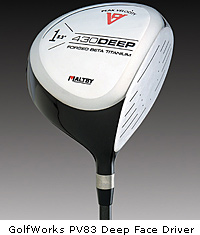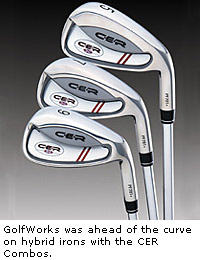 Sticks & Stones Sticks & Stones Component Clubs:
|
|
So why would someone with little inclination to tinker decide to build his own clubs? "Partially because I am a cheapskate when it comes to golf equipment," confesses Williams. "My driver and 7 wood cost me $14 for the head, $7 for the True Temper Dynamic Gold shaft, and $2 for a grip that I like. Total cost $23 for each club."
Andrew Hollingworth, a single-digit handicapper and amateur clubmaker since 1997, echoes Williams's sentiments. "Price is a big plus," he says. "The other big plus is being able to fine-tune and fiddle with your equipment to match your game. I can make sure my clubs are exactly 1/2" longer than standard yet have a normal swingweight."
Attack on the clones
To the naïve or brand-name obsessed golfer, component clubs are often associated with low-quality knock-offs or clones - blatant copies of well-known OEM (original equipment manufacturer) clubs. Britt Lindsey, VP for technical services and R&D at The GolfWorks in Columbus, Ohio, calls this topic "near and dear to my heart." Lindsey has recently written an article on this very subject for the February GolfWorks catalogue, documenting the vast differences between clones and high-quality component parts.
 "I can only speak for the GolfWorks," says Lindsey, "but we pride ourselves on doing original designs that actually work. There are always trends in design that all designers will evaluate and follow, but following material trends or design trends do not have to be knock-offs of the major brands. In fact, we currently see trends that seem to follow some of our own original design concepts of longer blade lengths and lower center of gravity with wider radiused soles."
"I can only speak for the GolfWorks," says Lindsey, "but we pride ourselves on doing original designs that actually work. There are always trends in design that all designers will evaluate and follow, but following material trends or design trends do not have to be knock-offs of the major brands. In fact, we currently see trends that seem to follow some of our own original design concepts of longer blade lengths and lower center of gravity with wider radiused soles."
For Lindsey's article, GolfWorks engineers inspected clone irons and found that not one model they tested even had a flat face. Callaway Golf has recently led the industry in litigation against knock-off producers, winning damages and forcing the removal of clones from store shelves. As Lindsey says, however, there are times when the OEMs actually follow the design trends of component producers.
Amateur clubmaker Hollingworth also warns against clones. "Don't start clubmaking just to make knock-offs of popular designs," he warns. "The cheap knock- offs are generally of very low quality. If you pay a bit more for high quality components, you will still pay significantly less than OEM clubs, and the quality will be as good or better than the OEMs."
Another widespread misconception is that all component clubheads are cast or forged in China, and all OEM clubheads come from the U.S. At the cost of domestic manufacturing jobs, however, in this age of "free trade" almost all clubheads are produced in China. According to Lindsey, "Years ago, many heads were made in the U.S. Some were made in Mexico. Having been [to China], I can tell you that every major brand is being produced in China. It may not be all the production, but it is the majority, I believe." Furthermore, both component and OEM heads are generally made at the same foundries, using the same materials and processes.
Putting together a complete game
The largest component companies in the U.S. are Golfsmith (based in Texas), GolfWorks, and Dynacraft (also in Ohio). Comprising between 10 and 20 percent of the total golf club market, component clubs hold broad appeal for players who want custom-made clubs. Some golfers, like Williams, decide to do the work themselves. Many more, however, rely on professional club-builders who can fit and adjust everything from putter to driver specifically for each player.
Jeff Summit of Dynacraft (dynacraftgolf.com) points out that the custom-fitting aspect of component clubs is really the difference between them and OEM products. "All clubs, whether they are Callaway, Taylor Made, or Dynacraft start out as components," says Summit. "The difference is who does the manufacturing. Unlike an OEM who does the assembly under one roof, a component supplier, such as Dynacraft, may have tens of thousands of independent assembly shops who specialize in custom fitting."
Lindsey agrees: "If custom fit by a professional clubmaker that has been properly trained, a set made from quality, original design components, custom fit to the individual and put together properly by the clubmaker is the best set anyone could play with."
Within the last half-dozen years, OEMs have apparently realized that golfers are not all cast from the same mold. Ping, Slazenger, Nike, Callaway, Taylor Made, and others have begun offering custom-fitting across the country. "I am actually glad to see some of the OEMs wake up to the fact that clubs need to be custom fit," says Lindsey, despite the increased competition.
"As for the price, I still think that most independent clubmakers using the highest quality parts will be less expensive than many of the OEMs," he adds. Comparing a custom-fitted set of Callaway X16 pros and a set of GolfWorks' Maltby M05s, Lindsey estimates that the latter would run about $156 less - $700 vs. $544.
Summit seconds that judgment: "A very well-built custom set may cost the same as a standard stock OEM set off of the rack. Custom clubs are truly a great value."
Setting up shop
Most golfers seek the expertise of professional clubmakers, even if they do decide that buying component clubs and saving money is more important than sporting the newest silicon-implanted Big Bertha. Summit points out that the range of products and services offered by accomplished clubmakers is nearly endless. "[U]pscale shops are equipped with full diagnostic equipment and launch monitors," he says, "and equipment that was privy to only touring professional a couple of years ago."
If, however, you like to tinker, it does not take much of an initial investment to set up shop. Companies like Dynacraft and GolfWorks even sell starter kits, containing the basics for the would-be club-builder. Williams lists the bare essentials of his workshop as: pipe-cutter, 48-inch ruler, 24-hour curing epoxy, sandpaper, grip-tape, grip-tape solvent, vice with tubing clamp, ferrules, masking tape, and Exacto knife. The extras in his workshop include a heat gun (for the removal of heads from broken shafts), swing-weight scale, acetone (for working ferrules), and a grit edge blade for a hacksaw (for cutting graphite shafts). Hollingworth adds lead tape to adjust swing weights and a graphite shaft extractor.
Williams points out that one of the happy consequences of building your own clubs "is that you have to learn what all of the equipment terms mean if you want to know what you are getting. If you don't want to know all of the specs of your clubs, you can probably still build them, but the whole point is to know what you are getting. So a little study will allow you to get more from the components you buy."
Ultimately, whether one settles on off-the-rack OEM clubs, custom-fitted OEMs, or custom-fitted component clubs, the goal is to find equipment that best suits your game. Playing with ill-fitting clubs is about as much fun as walking all day in ill-fitting shoes.
Any opinions expressed above are those of the writer and do not necessarily represent the views of the management. The information in this story was accurate at the time of publication. All contact information, directions and prices should be confirmed directly with the golf course or resort before making reservations and/or travel plans.